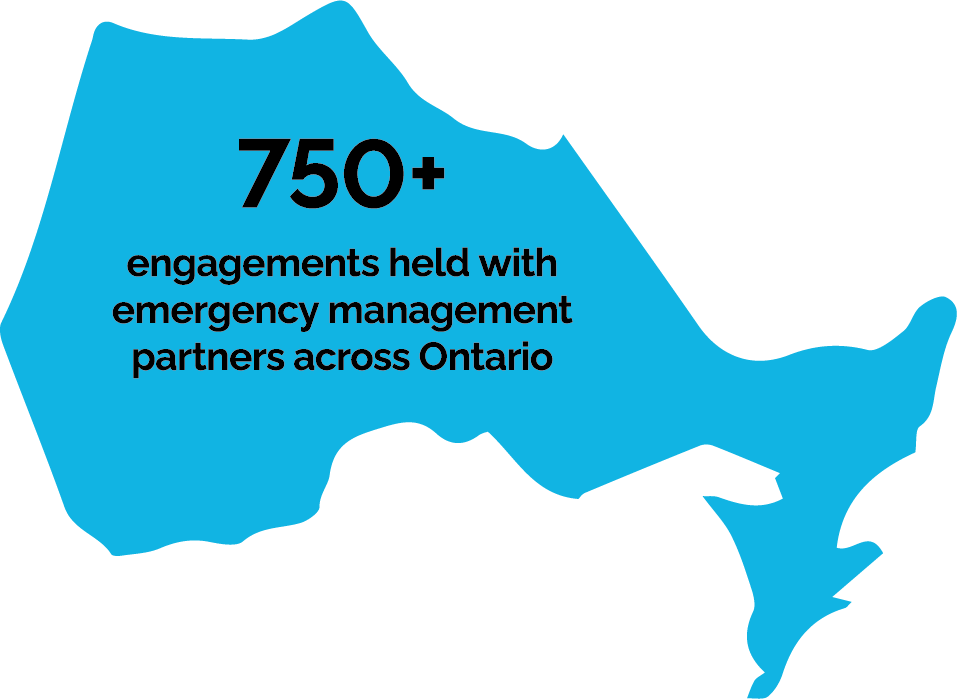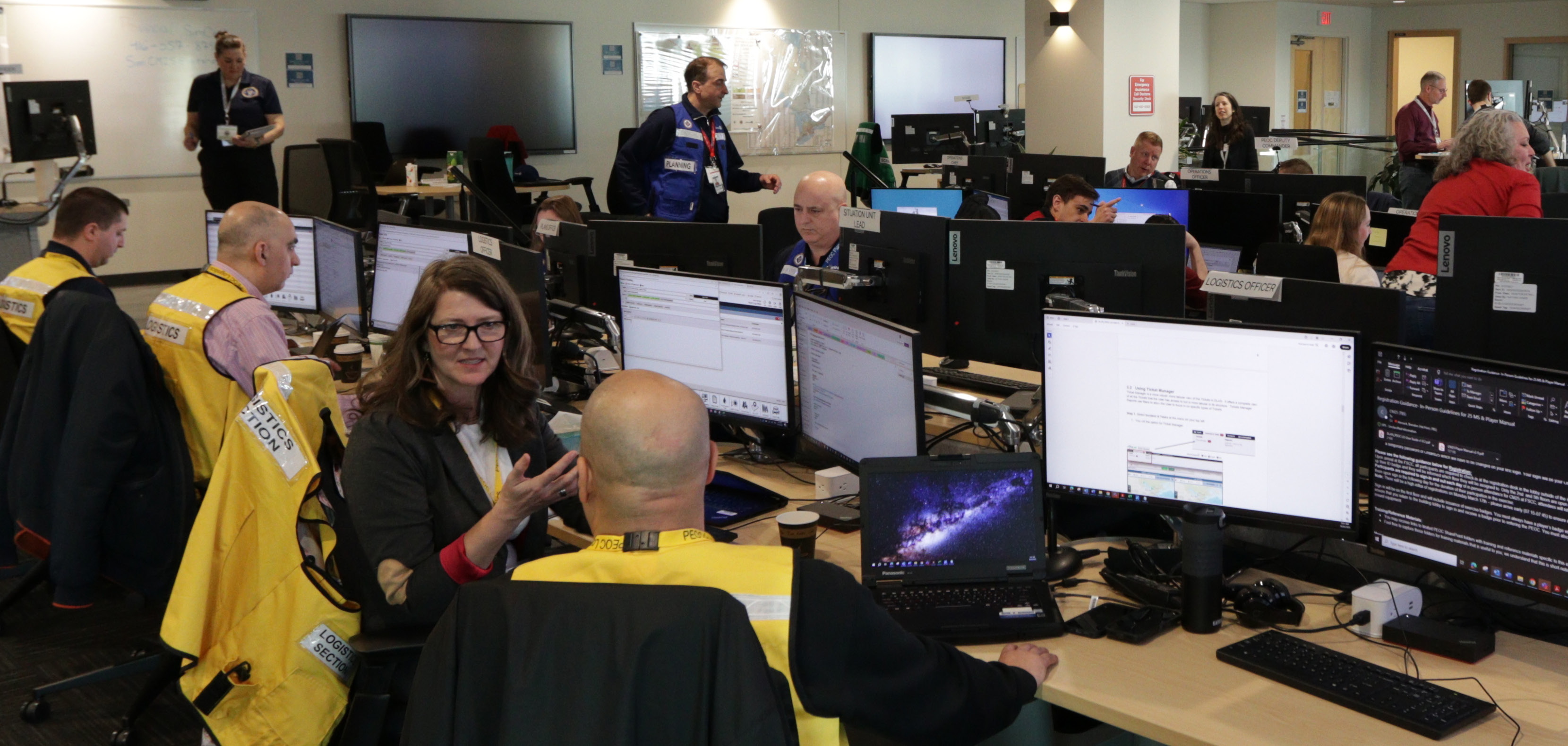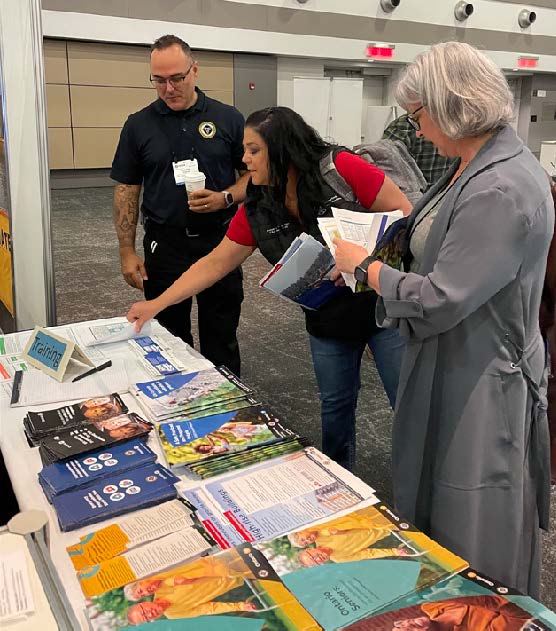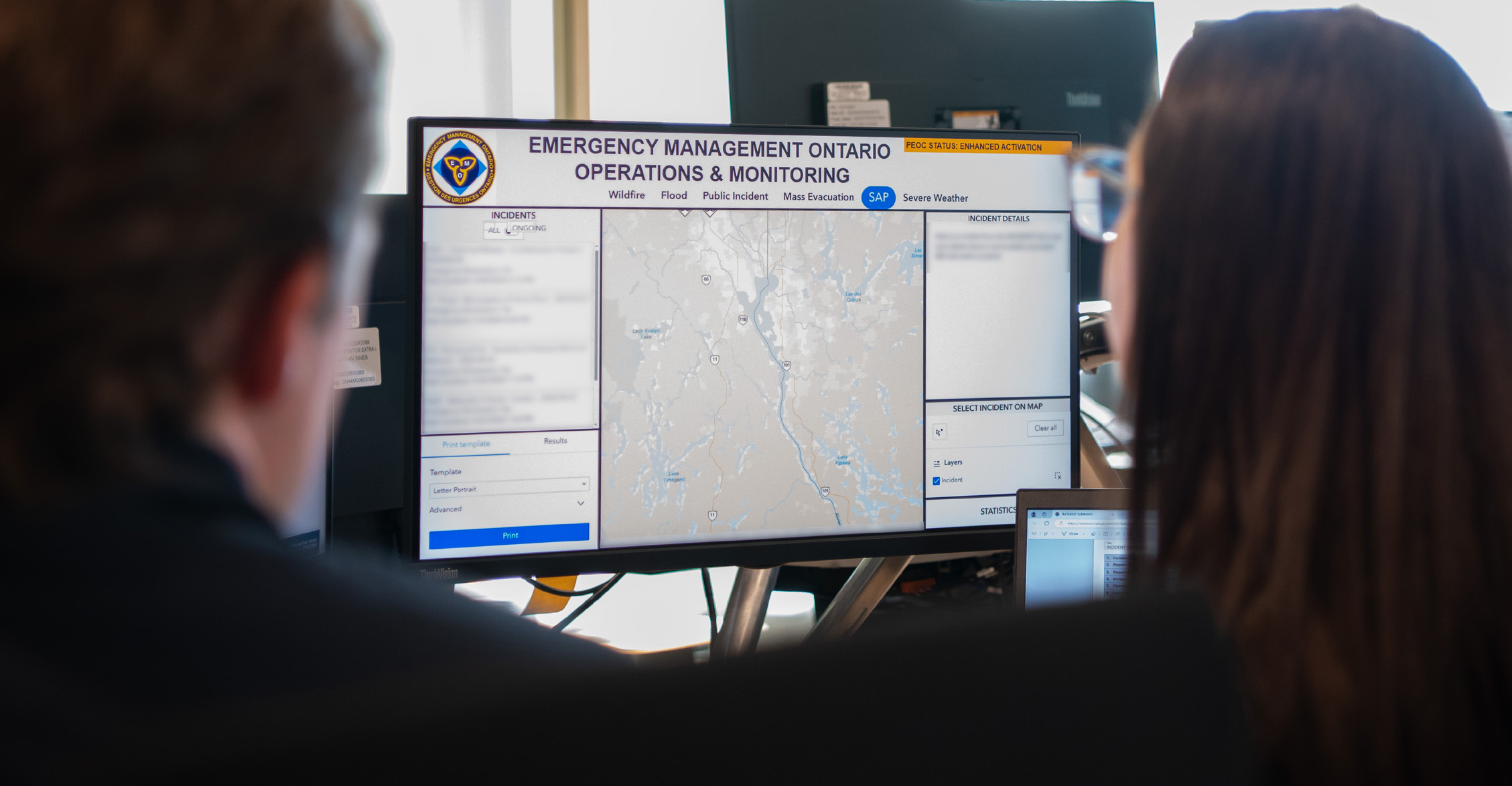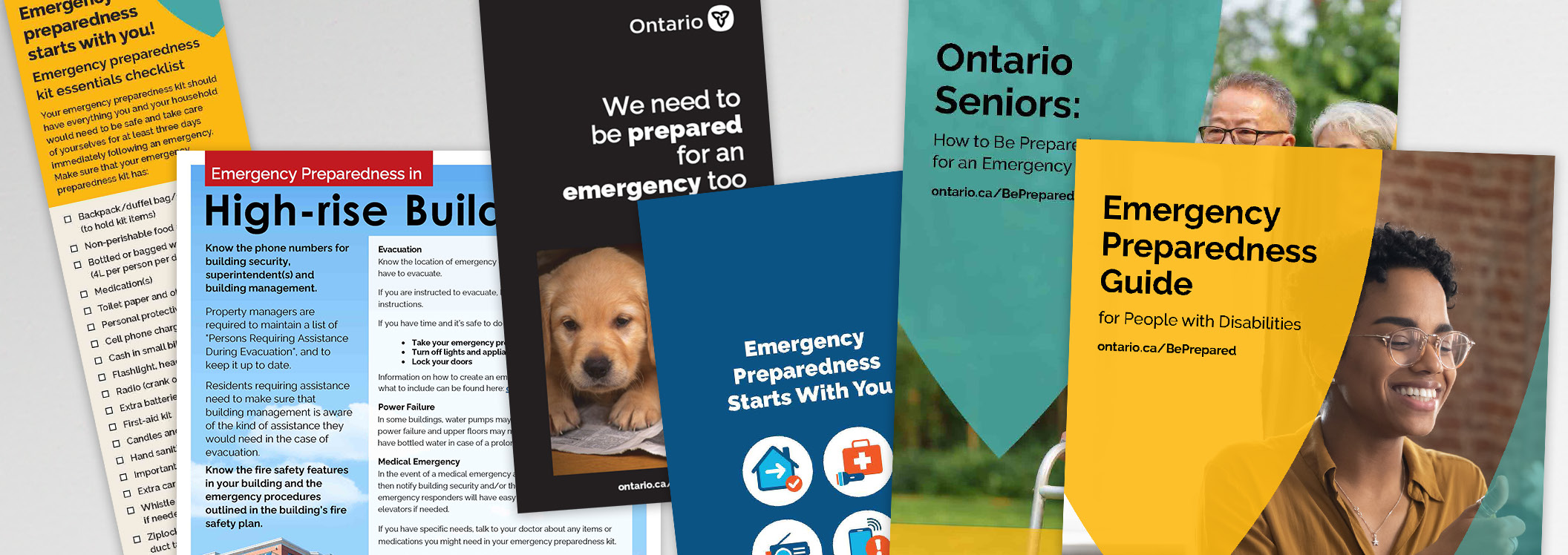A safe, practiced and prepared Ontario — 2024 Annual Report
Learn how we are building a stronger and more resilient Ontario.
Message from the Minister
The safety and well-being of Ontario residents is a top priority of our government. As the Minister of Emergency Preparedness and Response overseeing this very important responsibility, it is my honour to ensure our province is resilient, ready and strong in the face of all emergencies and natural disasters.
I am pleased to release the second annual report of the Provincial Emergency Management Strategy and Action Plan - the province’s roadmap for keeping Ontario safe. It outlines a clear goal for the province: Ontarians should be safe, practiced and prepared before, during and after emergencies. These emergencies include floods, wildland fires, ice storms, cyber security threats and more.
In 2024, our province created new partnerships and made significant investments in the necessary resources and tools to support the emergency management efforts of our communities. We launched Ontario Corps, a group of skilled professionals and volunteers that the province can deploy to respond to natural disasters and other emergencies. I encourage every Ontario resident to register. We also continued to make significant investments in communities across the province through the Community Emergency Preparedness Grant, a part of our government’s $110 million commitment over three years to strengthen emergency preparedness across Ontario.
We are thankful for the ongoing collaboration with emergency management partners, including municipalities and First Nations communities. These partnerships have been essential in modernizing our emergency management efforts and I look forward to working together to keep our families, friends and neighbours safe.
Together, we will continue to raise the bar for emergency management in Ontario.
Jill Dunlop
Minister of Emergency Preparedness and Response
Message from the Commissioner of Emergency Management
I am pleased to share the Provincial Emergency Management Strategy and Action Plan second annual report. The transparency and accountability showcased in this report highlight the province's unwavering commitment to safeguarding Ontarians, no matter the emergency.
Our team stands ready to support communities across Ontario anytime to prepare, plan, mitigate, respond, or recover from any emergency. In 2024, we responded to more than 100 significant emergency incidents, safely evacuated over 1,300 people, trained thousands of Ontarians and conducted dozens of exercises.
In addition, we strengthened partnerships with academic institutions throughout Ontario so the province can benefit from the best and brightest academics in emergency management while offering practical hands-on experiences. Collaborative efforts in knowledge sharing, research, and training will significantly enhance the province's emergency management capabilities.
Our continuous commitment to strengthening provincial leadership and coordination will help us modernize emergency management and ensure we are meeting the needs of communities across the province.
I look forward to our ongoing work with partners throughout Ontario and to ensuring the province is safe, practiced and prepared now and in the future.
Bernard Derible
Deputy Minister and Commissioner of Emergency Management

2024: A year in review
In 2024, Ontario made significant strides in implementing the goals and actions outlined in the Provincial Emergency Management Strategy and Action Plan. By modernizing and enhancing emergency management capabilities, the province effectively addressed a wide range of emergencies, including severe weather events, wildland fires and cyber incidents. Through sustained investments, strengthened partnerships, proactive support measures, and the deployment of innovative technology and tools, Ontario has strengthened collaboration, planning, and response efforts. These advancements ensure that communities across the province remain safe, practiced, and prepared for the challenges of today and the future.
109
significant emergency incidents
1,316
people evacuated
33
local emergency declarations
67
deployments of Emergency Management Ontario staff for a total of 355 days
388
emergency management courses delivered
16,549
people trained
Key public education materials translated into 13 languages
11
partnership agreements established with academic institutions
114
exercises and drills facilitated, observed and/or engaged in
Ontario Corps equipment and personnel ready to deploy within 24-72 hours
227
communities awarded grants through the Community Emergency Preparedness Grant since 2023
750+
engagements held with emergency management partners across Ontario
For a detailed overview of progress on actions outlined in the Provincial Emergency Management Strategy and Action Plan, visit the Appendix.
Progress on goal 1 — One window for all Ontarians
The province continues to implement a one-window approach through Emergency Management Ontario to ensure provincial emergency management is coordinated quickly and efficiently across the province.
Building and strengthening emergency management partnerships across the province
Ontario is committed to working with partners to enhance collaboration and information-sharing, reduce administrative burden, and ensure the unique needs of priority populations are informing emergency preparedness and response activities.
Throughout the year, Ontario led or participated in more than 750 virtual and in-person emergency management engagements with partners and stakeholders across the province. These partners included municipalities, First Nations communities and Indigenous partners, Local Service Boards and unincorporated territories, community and non-governmental organizations and critical infrastructure partners.
Engagement topics in 2024 included how the province can support community emergency management, including through Ontario Corps, enhancing provincial hazard identification and risk assessments to inform proactive planning, and proposed modernization of Ontario’s emergency management legislation, the Emergency Management and Civil Protection Act.
In 2024, over 45 virtual and in-person regional engagements were held, and 91 written submissions were received on a discussion guide to inform proposed amendments to the Emergency Management and Civil Protection Act introduced by the Ontario government in December 2024 and posted for public feedback.
Ontario’s initiatives at work in 2024 included:
Enhancing provincial operations capabilities: Significant enhancements were made to the infrastructure and response operation capabilities of the Provincial Emergency Operations Centre. The Provincial Emergency Operations Centre is staffed at all times and monitors evolving situations inside and outside of Ontario to ensure coordinated decision making and deployment of provincial resources as required. With renovations completed in 2024, the Provincial Emergency Operations Centre can coordinate up to three separate operations simultaneously, establishing a modern and effective environment of operational excellence. Leveraging both new technology and data-sharing agreements, Ontario is using map-based data tools, and open-source intelligence monitoring to advance incident identification and assessment. Moving forward, to further modernize emergency management across Ontario, the province is establishing an Ontario Emergency Preparedness and Response Headquarters— a state-of-the-art complex that will enhance response time and coordination of resources with partners.
Modernizing tools to support hazard monitoring and emergency response: Ontario has launched an initiative to build Remotely Piloted Aircraft Systems capabilities to support local community emergency response efforts. The province now has the capability to use drones to support municipalities and First Nations with information collection, hazard identification and mapping, with real-time information that can be shared digitally anywhere and anytime. Moving forward, this technology may assist Ontario’s work with partner organizations in areas such as search and rescue operations.
Strengthening partnerships with academic institutions: Ontario has established partnership agreements with 11 colleges, universities and research institutions across the province: Carleton University, Centennial College, Georgian College, Humber Polytechnic, Lakehead University, Nipissing University, Toronto Metropolitan University, University of Ottawa, University of Waterloo (Intact Centre on Climate Adaptation), Western University (Northern Tornadoes Project), and York University. These agreements support knowledge exchange and collaboration, which allows the province to leverage academic expertise and research to enhance emergency management practices, while providing students, faculty and researchers with practical experience and insights into the field.
For additional progress updates in 2024 related to Goal 1, visit the Appendix.
Initiatives in action across Ontario
Supporting Indigenous-led emergency preparedness and response along the James Bay Coast
Each year, to support preparedness for the annual flood risk to communities along the James Bay, Ontario deploys a team of experienced operational and field staff to provide planning assistance and training to enhance local capacity. Ontario continues to work in collaboration with First Nation communities and emergency management partners to support the effective coordination of evacuations, underscored by the commitment of supporting Indigenous-led emergency management practices and operations.
Grand Council Treaty #3 Health Emergency Management
On October 16–18, 2024, Grand Council Treaty #3 hosted a Health Emergency Management summit to support communities in building local capacities and identifying support resources during emergencies and significant incidents. The province participated and presented on new Indigenous emergency management training and supports co-developed with Indigenous emergency management partners available to First Nation communities.
Progress on goal 2 — Proactive planning and monitoring
Ontario continues to advance proactive planning and monitoring grounded in data, analytics and knowledge, and enhance digital tools and provincial supports for local emergency management.
Enhancing digital tools to modernize emergency management planning and monitoring in Ontario
The province continues to strengthen digital tools to support emergency response, hazard monitoring and coordination across Ontario.
Tools include map-based dashboards that focus on key areas such as wildland fires, floods and severe weather incidents to support enhanced monitoring across the province. For situational awareness and rapid incident assessments, the province is applying artificial intelligence to support ongoing monitoring of publicly available sources, including social and news media sites.
Ontario also continues to enhance digital tools to support partners, including the launch of an online portal for emergency management resources, as well as the development of interactive geographic and socio-economic profiles of municipalities and the neighbourhoods within them. These profiles provide a comprehensive and data-driven approach for emergency managers to gain accurate insights into their communities’ exposure to and preparedness for hazards and emergency incidents and will enhance planning and preparedness for emergency hazards and impacts on priority populations.
Ontario’s initiatives at work in 2024 included:
Enhancing preparedness through public education: The province has launched a public education strategy for emergency management, using data-driven and collaborative public education programming to support all Ontarians. This strategy includes the development of public education materials in 13 languages, including three Indigenous languages, and tailored preparedness guides to support Ontarians, including seniors and people with disabilities.
Strengthening culturally relevant training for partners: Building on ongoing actions to support culturally relevant training in collaboration with partners, the province launched three pilot sessions of a foundational emergency management course that supports First Nation and Indigenous communities. Feedback from these sessions and ongoing dialogue with partners continues to inform the enhancement of culturally relevant learning opportunities and supports.
Enhancing data-driven hazard preparedness and monitoring: The province updated the Hazard Identification and Risk Assessment program, including Ontario’s first Provincial Risk Profile. The new program, informed by partner engagement and feedback, includes updated materials, resources, and best practices related to Ontario’s hazard and risk landscape to inform provincial hazard preparedness, monitoring and response efforts and increase resiliency.
For additional progress updates in 2023 related to Goal 2, visit the Appendix.
Initiatives in action across Ontario
Emergency Preparedness Initiatives
Throughout 2024, several municipalities across the province led initiatives to share information with their communities about how to stay safe, practiced and prepared in case of an emergency. During Emergency Preparedness Week from May 5-11, 2024, the City of Guelph hosted an emergency preparedness pavilion, featuring educational booths and activities with over 30 agencies presenting from all levels of government, private sector and local partners to give members of the community the opportunity to interact with subject matter experts and learn how they can be better prepared should a disaster strike. The province participated in various municipal events, including setting up educational booths in communities across the province. In July 2024, the City of Markham hosted its 6th annual Master of Disaster camp, in collaboration with their emergency management partners. The camp taught children how to prepare for emergencies through fun, hands-on activities. Participants learned to identify hazards, create family emergency plans, and use household items to build their own emergency kits, helping to build awareness and resilience at a young age.
Be prepared. Know your risks.
In February 2024, the province conducted a survey of Ontarians across key demographics to understand the factors that could improve public awareness and understanding of emergency preparedness
Based on the results of this research it was found that:
-
95% of Ontarians surveyed do not feel adequately prepared for emergencies
-
16% do not have an evacuation plan
-
24% have learned about emergency risks
-
41% have food and water supplies for emergencies
-
9% have a household emergency plan
-
15% have an emergency preparedness kit
Ontario's top five hazards in 2024
-
Electrical Energy Failure
-
Flooding
-
Road and Highway Incident
-
Wildland Fire
-
Winter Weather
Ontario's emerging hazards in 2024
-
Artificial Intelligence
-
Climate Change
-
Critical infrastructure Interdependencies
-
Cyber Incidents
-
Infectious Disease
-
Tornado
To learn more about how you can be prepared for an emergency, visit: Be prepared for an emergency.
Progress on goal 3 — Practiced and prepared emergency response
Ontario is working to modernize and expand emergency management capabilities to ensure Ontarians are practiced and prepared for any potential future emergency through strengthened partnerships, enhanced resources and ongoing emergency management training and exercises.
Strengthening support for communities through Ontario Corps
In December 2024, the province announced the creation of Ontario Corps, a group of skilled professionals and volunteers that the province can deploy to help communities respond to natural disasters and other emergencies, while promoting civic engagement and community participation.
Ontario Corps works with non-governmental organizations and Indigenous partners to help coordinate specialized personnel and volunteers to respond to emergencies. Ontario Corps can mobilize to provide on-the-ground assistance such as emergency shelter, debris management, food services, and flood protection.
To support Ontario Corps emergency response efforts, the province has procured flood mitigation barriers, drones, water pumps, chain saws, air purifiers and other supplies to support communities impacted by emergencies. All equipment and volunteers can be deployed anywhere across Ontario within 24 to 72 hours to help support community response efforts.
The Ontario Corps Volunteer Portal is open to Ontario residents aged 16+. Volunteers from all skill levels and professional backgrounds are encouraged to apply. Volunteers can be trained to perform a variety of duties and are contacted by Ontario Corps when needed to support emergency response efforts. We encourage everyone to register.
Ontario’s initiatives at work in 2024 included:
Investing in local emergency management preparedness: In 2024, the province continued to support local communities in emergency preparedness through the Community Emergency Preparedness Grant, a merit-based grant of up to $50,000 for municipalities, First Nations, Local Services Boards and community groups across the province to purchase equipment and services needed to improve local emergency preparation and response. One hundred and thirteen applicants received funding for Round 1 (2023–24) of the program, and 114 new applicants for Round 2 (2024–25), totalling $10 million in awarded grants to date.
Strengthening multi-sector emergency management coordination and whole-of-government emergency response: Ontario implemented the first provincial priority exercise in 2024 as part of the Provincial Exercise Program, Ontario’s multi-year plan to exercise, test and strengthen multi-sector emergency plans and whole-of-government emergency response. Exercise Heatwave took place from May 7–9, 2024, during Emergency Preparedness Week. Over 24 ministry, municipal, federal and other partners and stakeholders participated across the province.
Connecting local emergency management partners across the province to key equipment and services: Ontario continues to enhance emergency management support across the province including through the establishment of a regional hub in Timmins. This will provide a space for training, exercises, collaboration with partners, and an emergency operations centre as needed when emergencies arise. Supplies and equipment to support emergency response will be stored and available for deployment. Four additional emergency hubs will be established at strategic locations in northeast, northwest, southwest and southeast Ontario.
For additional progress updates in 2024 related to Goal 3, visit the Appendix.
Initiatives in action across Ontario
Severe winter storm response
Between November 30 and December 6, 2024, an unprecedented snowstorm closed highways and left 150,000 households without power across the province. Given the community impacts of the storm, the Town of Gravenhurst declared a local emergency. The province coordinated additional support for the town, including the deployment of Emergency Management Ontario field officers and Ontario Corps partners, such as GlobalMedic, Ontario Search and Rescue Volunteer Association, Salvation Army and Feed Ontario. During this deployment, Ontario Corps partners supplemented local community response efforts by conducting wellness checks, staffing the community warming centre by cooking and serving meals, and distributing food supplies.
Emergency preparedness with Team Rubicon
In November 2024, Team Rubicon Canada hosted a week-long training camp to practice their emergency response capabilities. As part of the training camp, a joint exercise was held to practice the deployment of Ontario Corps resources. This exercise provided an opportunity to streamline the deployment process and ensure Ontario Corps partners are prepared in the event of deployment. It also provided an opportunity to run through the deployment of an incident management team in the field. This exercise and the processes that it helped to refine directly contributed to the successful deployment of Ontario Corps in support of the 2024 Gravenhurst snowstorm. Looking forward, Emergency Management Ontario plans to continue to train and exercise with Ontario Corps partners.
Moving forward
Ontario will continue to work with partners to ensure the province is safe, practiced and prepared — before, during and after emergencies.
Key initiatives moving forward include:
- Continued modernization: Ontario will continue to modernize provincial emergency management through updated policies, programs and frameworks, ensuring they meet the evolving needs of our communities.
- Enhanced supports for partners: Ontario is dedicated to providing enhanced supports to our partners to strengthen emergency preparedness. This includes Community Emergency Preparedness Grant funding, integrated emergency management exercises, relevant and accessible training programs and strengthened public education initiatives for all Ontarians.
- Practiced and strengthened capabilities: Actions to keep Ontario safe, practiced and prepared will be bolstered by continued support through the deployment of regional field officers and Ontario Corps, the establishment of regional hubs, and the development of a state-of-the-art headquarters.
Together, these initiatives will ensure we continue to build a resilient and prepared Ontario, ready to face the challenges of today and the future.
To learn more about emergency management Ontario, including how you can be safe and prepared, visit Emergency management.
Appendix: Key progress on the goals and actions in the Provincial Emergency Management Strategy and Action Plan
Goal 1 — One window for all Ontarians
Strengthen Ontario's governance and accountability by establishing an action-oriented one window for provincial emergency management coordination
- Enhanced and modernized emergency management operations across the province, including:
- The modernization of the Provincial Emergency Operations Centre,
- Establishing an Ontario Emergency Preparedness and Response Headquarters to support quicker and more coordinated emergency response,
- Transforming emergency management procurement practices through the creation of the Operational Support Services team to streamline work, reduce red tape, create operational efficiencies and reduce workload, including by partnering with Supply Ontario to establish centralized warehousing and distribution capabilities to deliver supplies when and where they are needed,
- Building Remotely Piloted Aircraft Systems capabilities to support local community emergency response efforts.
- Continued to implement Ontario’s governance and accountability framework to ensure whole of government coordination, information sharing and oversight on emergency management through the Cabinet Committee on Emergency Management and Deputy Ministers Steering Committee on Emergency Management.
- Continued to work with federal-provincial-territorial partners to advance Canada-wide emergency management priorities, and as of April 2024, has undertaken provincial co-chair responsibilities in the federal-provincial-territorial emergency management forum.
- Provided a variety of wildland firefighting resources to other jurisdictions including Alberta, British Columbia, the Northwest Territories and Parks Canada, Montana, Idaho, and Minnesota. Resources provided included wildland firefighting crews, incident management team staff, aircraft operations support staff, support in fixing wing and rotary aircraft, hoses, and tool kits.
- Participated in cross-border exercises and engagements including an exercise in the Windsor Tunnel, a presentation at the Grand Council Treaty #3 meeting in Manitoba and a visit to the Federal Emergency Management Agency Region 2 in New York City.
- Under the Ministry of Public and Business Service Delivery and Procurement’s leadership, passed new provincial legislation to provide tools to prevent and respond to cyber security threats and safeguards for critical public services, such as health care and education through the Enhancing Digital Security and Trust Act, 2024.
Ensure the unique needs of vulnerable populations are considered throughout the emergency management cycle
- Continued engagement with partners to support integration of priority populations in emergency management planning and response, including through the 2024 renewal of the provincial Hazard Identification and Risk Assessment Program, municipal profiles and proposed modernization of the Emergency Management and Civil Protection Act.
- Advanced multilateral emergency management partnership agreements with First Nations communities, Indigenous organizations and federal partners. Key priorities include emphasizing all components of emergency management, addressing capacity needs and securing sustainable funding.
- Continued enhancement of partnerships with First Nations communities and Indigenous service organizations to inform ongoing work, share information, enhance Traditional Ecological Knowledge, and support communities in emergency management activities:
- Engaged with First Nations communities and Indigenous Service Organizations during meetings with community emergency management representatives.
- Attended and presented at the Grand Council Treaty #3’s Health Emergency Management summit.
- Led Practiced and Prepared 2024, a virtual conference with First Nations partners to prepare for flooding and wildland fire season.
- Piloted a foundational emergency management course that supports First Nation and Indigenous communities to garner feedback and inform the enhancement of culturally relevant learning opportunities and supports.
Increase clarity of Ontario's emergency management approach and structure and reduce administrative burden for emergency management partners
- Led or participated in more than 750 virtual and in-person engagements with emergency management partners and stakeholders across the province, including municipalities, First Nations and Indigenous partners, Local Service Boards and unincorporated territories, community and non-governmental organizations and critical infrastructure partners. Engagement topics included proposed modernization of the Emergency Management and Civil Protection Act, renewal of the provincial Hazard Identification and Risk Assessment program, sector meetings, Ontario Corps and other opportunities to enhance collaboration and reduce administrative burden for partners. This included over 45 virtual and in-person regional engagements and 91 written submissions on a discussion guide to inform proposed amendments to the Emergency Management and Civil Protection Act introduced by the Ontario government in December 2024 and posted for public feedback.
- Worked with the Ministry of Natural Resources and Ministry of Children, Community and Social Services to coordinate legislative proposals to amend the Forest Fires Prevention Act and the Ministry of Community and Social Services Act.
- Participated as the host provincial partner of the first Canadian Emergency Preparedness and Climate Adaptation Convention. Ontario presented at the strategic conference and hosted an interactive exhibition booth, which included features on public education, demonstrations on proactive planning and monitoring tools, and advancements in resources for emergency management partners.
Goal 2 — Proactive planning and monitoring
Use data and knowledge to inform emergency management decisions
- Developed profiles of the province’s unincorporated territories and suite of geographic and socio-economic profiles to enhance monitoring and surveillance related to emergency hazards and risks and their impacts on vulnerable populations:
- Profiles of Ontario's unincorporated territories were shared with emergency management partners, including Local Services Boards and Community Emergency Management Coordinators. These 18 profiles (nine English, nine French) contain demographic information and maps with key geospatial features for each territory, plus sections for each Local Services Board in the territory.
- An interactive Municipal Profiles Tool has been created, which provides geographic and socio-economic profiles of municipalities and the neighbourhoods within them. These profiles provide a comprehensive and data-driven approach for emergency managers to gain accurate insights into their communities’ exposure to and preparedness for hazards and emergency incidents and will enhance planning and preparedness for impacts on priority populations.
- Enhanced emergency management planning and monitoring through the development and use of digital tools. These tools enhance situational awareness, improve efficiency, enhance planning and response activities, and accelerate incident assessments. These tools include:
- Map-based dashboards that focus on key areas such as wildland fires, floods and severe weather incidents to support enhanced emergency management monitoring across the province.
- An open-source intelligence monitoring tool to aid in maintaining situational awareness and rapid incident assessments.
- Continued engagement with the established First Nations All Hazards Working Group, co-led by the First Nations Emergency Response Association, focusing on integrating Traditional Ecological Knowledge in emergency management practices that support communities in becoming more self-reliant before, during and after emergencies
Proactively identify the likelihood and impact of risks in the province
- Updated the Hazard Identification and Risk Assessment program including a new Hazard Identification report that includes 74 comprehensive hazard profiles and Ontario’s first Provincial Risk Profile.
Identify, support and develop provincial capabilities for top provincial hazards
- Continued to identify, support and develop provincial capabilities for top provincial hazards.
- Continued to enhance the goods and services available during response through programs such as Ontario Corps, regional hubs and the Incident Management Team.
Develop support resources for emergency management partners
- Launched Emergency Management Ontario Central, an online portal with emergency management resources for partners.
- Launched a new public education strategy for emergency management, using data-driven and collaborative public education programming to support all Ontarians. This strategy includes the development of public education materials in 13 languages, including three Indigenous languages, and tailored preparedness guides to support Ontarians, including seniors and people with disabilities.
- Continued to modernize key emergency management courses in collaboration with partners to better serve Ontario’s diverse population, including the launch of three pilot sessions for a foundational emergency management course that supports First Nation and Indigenous communities, and a new Emergency Information Officer course piloted in 2024. Ontario also continues to conduct an agency approver model pilot to accredit more training course instructors.
- Coordinated engagements during Emergency Preparedness Week to support local public education, including by setting up educational booths in multiple municipalities to share information about how to stay safe, practiced and prepared in case of an emergency.
Goal 3 — Practiced and prepared emergency response
Implement a Provincial Exercise Program and review, update and create new provincial emergency response plans
- Completed the first provincial priority exercise, Exercise Heatwave, on May 7–9, 2024.
- Continued to enhance relationships with nuclear energy partners, including by observing a security exercise at Bruce Power.
- Continued work on enhancing provincial emergency management coordination in alignment with emergency management modernization across government.
Enhanced provincial surge capacity through Ontario Corps
- Launched Ontario Corps, a network of skilled professionals and volunteers that the province can deploy within 24 to 72 hours to help communities impacted by emergencies. This includes:
- Ontario Corps Volunteer Portal,
- Partnerships with experienced non-governmental and Indigenous organizations,
- Incident Management Team to support community emergency response,
- Regional hubs to bolster local on-the-ground response and enhance emergency readiness.
- Ontario Corps activities in 2024 included:
- Coordinating support for the Town of Gravenhurst including conducting wellness checks, staffing the community warming centre, cooking and serving meals, and distributing food supplies.
- Training sessions led by GlobalMedic including a seminar on the proper use, storage, and transport of naloxone and a flood barrier exercise.
- An exercise led by Team Rubicon which included the deployment of Ontario’s Incident Management Team and tested the province’s operational procedures and coordination with Team Rubicon.
- Supported local emergency management through the Community Emergency Preparedness Grant, a merit-based grant of $5,000 to $50,000 for municipalities, First Nations, Local Services Boards and community groups across the province to purchase equipment and services needed to improve local emergency preparation and response. For Round 1 (2023-24), 113 applicants received funding, and 114 new applicants received funding for Round 2 (2024-25), totalling $10 million in awarded grants to date.
Footnotes
- footnote[1] Back to paragraph Research was conducted in collaboration with the external vendor, Mission Research. Margin of error is +/-2.8 percentage points, 19 times out of 20.












